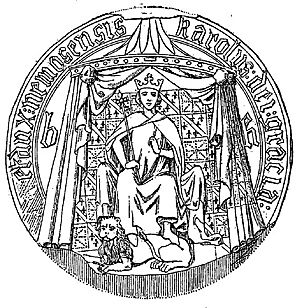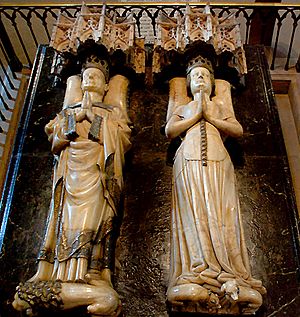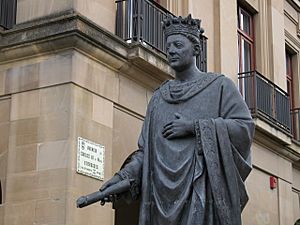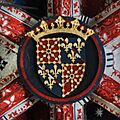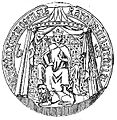Charles III of Navarre facts for kids
Quick facts for kids Charles III |
|
|---|---|
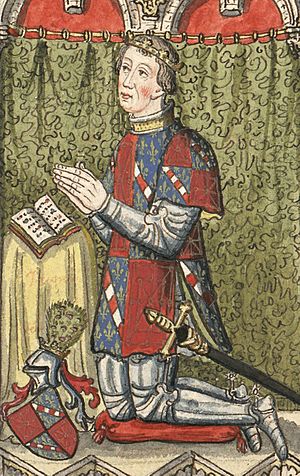
A picture of Charles from a stained glass window in the Évreux Cathedral
|
|
| King of Navarre | |
| Reign | 1387–1425 |
| Predecessor | Charles II |
| Successor | Blanche I |
| Born | 22 July 1361 22 July 1361 Mantes-la-Jolie |
| Died | 8 September 1425 (aged 64) Royal Palace of Olite |
| Burial | Pamplona Cathedral |
| Spouse | |
| Issue more... |
|
| House | Évreux |
| Father | Charles II of Navarre |
| Mother | Joan of Valois |
Charles III (born 22 July 1361 – died 8 September 1425), also known as Charles the Noble, was the King of Navarre from 1387 until his death. He was also the Count of Évreux from 1387 to 1404. He later traded Évreux for the Duchy of Nemours.
As a young man, Charles often served as an envoy for his father, King Charles II of Navarre, in France. His family had important lands and royal connections there. After his father's difficult rule, Charles III worked to improve Navarre. He wanted to make its buildings and systems better, restore its pride, and fix problems with France.
At first, Charles saw himself as a French prince. But over time, Navarre's foreign policy focused more on its neighbors in the Iberian Peninsula (modern-day Spain and Portugal).
Charles's marriage to Eleanor of Castile had some challenges early on. They disagreed about the rights of their daughters to inherit the throne. The couple later made up after Charles confirmed that their daughters would be his only successors. Charles was very good at making alliances. He arranged marriages for his sisters and daughters with powerful lords in France and princes in Iberia. This helped keep Navarre peaceful for a long time. He also tried to make the monarchy look more important through art, fancy court events, and building projects. Since most of his children passed away before him, his third daughter, Blanche I, became queen after him.
Contents
Early Life and Family
Charles III was part of the House of Évreux, a branch of the French royal House of Capet. He was the first son of King Charles II of Navarre and the French princess Joan of Valois. He was born on 22 July 1361, in Mantes-la-Jolie, France. This area was important land for his father. His parents often stayed there to manage their lands during the Hundred Years' War. Since 1234, the Kingdom of Navarre had been ruled by French kings. These kings improved Navarre's government and made it more respected internationally. However, their long absences from Navarre worried their subjects in Iberia.
King Charles II went back to Navarre in November 1361, leaving his wife and son in France. In January 1363, Queen Joan moved to Navarre. She left Charles with his aunt Blanche, who was his father's sister. Charles saw his mother again when she returned to France in December 1365. The next August, Charles visited his father's kingdom for the first time.
Charles's parents often traveled between their French lands and their kingdom in Iberia. In 1369, when his father was away, Charles was already called the "lieutenant of the kingdom," even though he was very young. Navarre faced difficulties because of King Charles II's conflicts with the French kings. These problems were made worse by issues common across Europe at the time, like bad weather and food shortages. Queen Joan died suddenly in November 1373 while on a diplomatic trip.
His Marriage
On 27 May 1375, Charles married Eleanor in Soria, Spain. Eleanor was the daughter of King Henry II of Castile. This marriage helped create peace between their fathers. Both Charles and Eleanor were teenagers when they married. Eleanor stayed in Castile, and Charles visited her when he wasn't in Navarre or at the French royal court in Paris.
In 1378, Charles was sent by his father to visit King Charles V of France. The French king arrested his nephew Charles and took control of the Évreux lands in France. During questioning, young Charles revealed his father's plan to take the town of Logroño. The French king warned the King of Castile, who then invaded Navarre. This forced Charles's father to sign the Treaty of Briones. Eleanor helped Charles get released in 1381 by asking her brother, King John I of Castile, to use his influence. After his release, Charles joined Eleanor in Castile.
Charles and Eleanor's first child, a daughter named Joan, was born in Castile in November 1382. Two more daughters, Marie and Blanche, were born in Castile in the next few years. Twin daughters were born the following year, but only one, Beatrice, survived.
Charles Becomes King
Charles III became king of Navarre and count of Évreux when his father passed away on 1 January 1387. In the same year, he got back the last parts of Navarre that Castile had taken over.
Family Challenges
The first years of Charles III's reign were difficult because of problems with his wife, Eleanor. She and their daughters joined him in Navarre when he became king. But the new queen soon became very ill. She returned to Castile as soon as she felt better, taking their daughters with her. She refused to come back for seven years, even though Charles sent people to ask her. This hurt the relationship between Charles and her brother, King John I of Castile.
Eleanor claimed that Charles did not treat her like a queen should be treated. She was worried that her daughters' rights to inherit the throne might be in danger. The laws of Navarre, called the Fueros, said that only children born within marriage could inherit.
Still separated from his wife, Charles had his coronation alone in 1390. From that year on, Charles tried to fix his marriage. First, he promised Eleanor that only their children would succeed him. He called their oldest daughter, Joan, to Navarre to be sworn in as the next in line for the throne. This ceremony happened on 25 July, with many nobles and Castilian visitors present. Eleanor still wasn't fully satisfied. But when her brother John died and her nephew King Henry III of Castile became king, she had to compromise. She asked for more promises about her safety. Charles swore before Castilian representatives that he would protect her and treat her well. Eleanor then returned to Navarre, reuniting with Charles in November 1394.
Soon after they made up, Charles and Eleanor had another daughter, Isabel, in July 1396. The next September, Charles confirmed that all five of their daughters had the right to inherit. The birth of sons, Charles in June 1397 and Louis in 1402, was a great joy for the king and queen. Young Charles was confirmed as the next in line, but both he and Louis passed away in 1402. The royal couple had another daughter, Margaret, the next year. Charles hoped to have another son with Eleanor until at least 1412. The king and queen seemed to have no more disagreements after Eleanor's coronation in 1403. Charles even trusted her to rule the kingdom while he visited his French lands.
Working with Other Countries
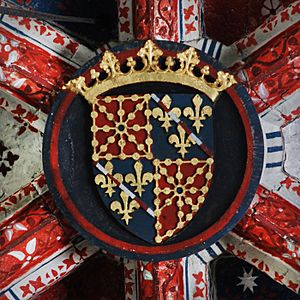
In 1393, Charles made a connection to the Aragonese royal family. He arranged for his sister Marie to marry Duke Alfonso II of Gandia. In the same year, he got Cherbourg back from the English. He also started talks with the French court about his land claims in France. This led to him exchanging his inherited counties for other payments and the Duchy of Nemours. Charles III was active in European affairs as a royal prince of France until 1406. After that, he focused more on the Iberian Peninsula.
Charles was very skilled at diplomacy. Much of the peace and wealth Navarre enjoyed during his rule was thanks to the marriage alliances he made. He connected his nobles and rulers in Iberia and southern France through his many female relatives. Between 1396 and 1406, he carefully arranged the marriages of two of his sisters and three of his daughters. These marriages were very important for his kingdom's alliances. Charles also benefited from marriages he didn't plan, like his sister Joan's marriages to Duke John IV of Brittany and King Henry IV of England. When Joan became queen of England in 1402, Charles gave her a special book about English coronations.
Plans for the Future
From 1401 to 1402, Charles discussed marriage plans with King Martin of Aragon. Martin's only son, King Martin I of Sicily, had recently lost his wife. Charles was pleased that the King of Aragon was interested, as Martin had turned down other powerful princesses. Charles chose his third daughter, Blanche, for this marriage, even though she had older sisters. This suggests that neither king wanted their kingdoms to become one. At the same time, Charles also arranged for Joan, his eldest daughter, to marry John, the heir to the County of Foix. Joan's marriage to John happened in October 1402, a few months after her brothers passed away, making her first in line to the throne again. These two marriages, and Beatrice's marriage to Count James II of La Marche in 1406, cost Charles a lot of money. His struggles to pay their dowries led to disagreements with their new families, especially the King of Aragon. In 1406, Charles and Eleanor's second daughter, Marie, also passed away.
Charles left the kingdom to Eleanor and their daughter Joan from 1408 to 1411. During this time, he was seeking payment from the French royal court for lost lands. When Blanche became a widow in 1409, Charles used his connections in France to arrange for her to marry a French prince. The death of his eldest daughter, Joan, in July 1413, made Charles look for a closer match for Blanche, who was now the main heir.
Blanche's situation in Sicily was difficult after her husband and father-in-law died. She was in charge of the unstable island kingdom for the new king, Ferdinand I of Aragon, but without much support. Charles was very worried. He sent envoys to Ferdinand and the Holy See (the Pope) asking for Blanche to return to Navarre or get help. Blanche returned and was confirmed as the heir before the Cortes (Navarre's parliament). Charles refused Joan's widower's offer to marry Blanche. Instead, in mid-1414, he offered Blanche to Alfonso, the eldest son of the new King of Aragon. Since Alfonso was already engaged, Ferdinand suggested his third son, Henry. Charles was upset and refused the offer in August. This happened when Ferdinand's second son, John, broke off his engagement to Charles's younger daughter Isabel. Isabel was then married to Count John IV of Armagnac. This showed that Charles was changing his alliances during the Armagnac–Burgundian Civil War in France. This change might have been because Burgundy was allied with England, where Charles's sister Joan was held prisoner.
In 1416, Charles III followed the example of other kings in Europe. He stopped supporting the Avignon-based Antipope Benedict XIII as the true pope. Instead, he switched his support to Pope Gregory XII, who ruled in Rome.
The Aragonese still wanted Blanche to marry into their family. Their queen, Eleanor of Alburquerque, pushed for her second son, John, to marry Blanche. Their marriage took place in October 1419, after many months of talks. During these talks, Blanche's position as heir was confirmed. Charles promised not to remarry and have more sons who could take Blanche's place. When Blanche gave birth to a son, Charles, the king celebrated by creating the Principality of Viana for him. Blanche soon had a daughter named Joan. King Charles held formal ceremonies to show that both grandchildren were in the line of succession after Blanche.
Later Years
Charles worked hard to make the monarchy seem grand. He supported artists, gave special gifts, and believed in royal healing powers. The building of the Gothic Cathedral of Pamplona and the royal palaces in Olite and Tafalla were finished under his orders. In 1423, he ended hundreds of years of conflict between the three parts of Pamplona by uniting them into one city.
On 8 September 1425, Charles III woke up feeling well. But he suddenly collapsed. He was able to call for Blanche, but he could not speak by the time she arrived. He passed away in his daughter's arms on the same day. Blanche became queen without any problems. Charles was buried in the Cathedral of Pamplona next to his wife, Eleanor.
His Legacy
Charles III left his daughter a kingdom that was stable and doing well. Historians still discuss whether he saw himself more as a French prince or an Iberian king. But it is clear that Navarre became more focused on Iberia during his rule. People often say that Charles III's reign was a time of peace within Navarre. He focused on improving the kingdom, unlike his father who was involved in the Hundred Years' War. His financial changes brought back some wealth and happiness after his father's difficult rule. His court was also known for its splendor. Charles III was also very good at diplomacy. Because of this, unlike his father, Charles "the Bad," Charles III earned the nickname "the Noble."
Children
Charles and his wife, Eleanor of Castile, had seven daughters and two sons:
- Joan (1382–1413), who was the heir to the throne and married John of Foix.
- Marie (1383 or 1384 – 1406), who was often unwell throughout her life.
- Blanche (1385–1441), who became Charles's successor. She married Kings Martin I of Sicily and John II of Aragon.
- Beatrice (1392–1412), married to Count James II of La Marche.
- A twin sister of Beatrice, who passed away young.
- Isabel (1396–1435), married in 1419 to Count John IV of Armagnac.
- Charles (1397–1402), who was the heir to the throne of Navarre during his short life.
- Louis (1402), who passed away within months of his birth.
- Margaret (1403), who passed away young.
Images for kids
See also
In Spanish: Carlos III de Navarra para niños





